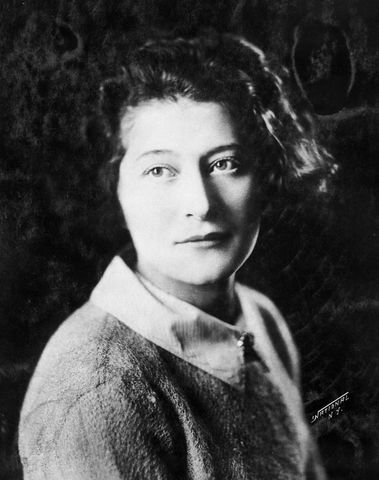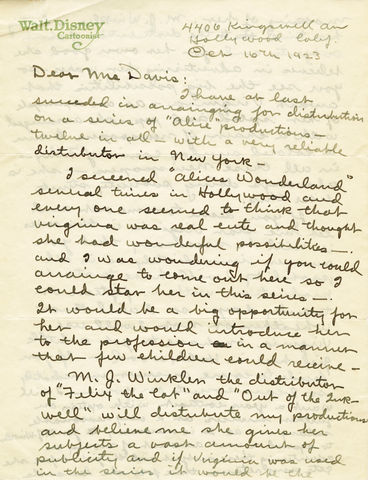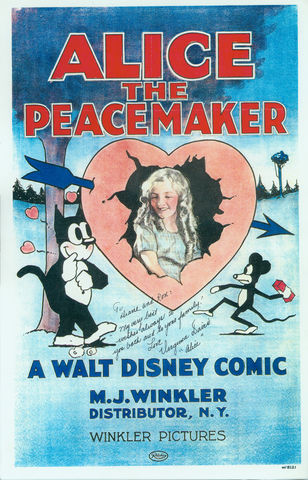The Walt Disney Company, now celebrating its 100th anniversary, began with a deal made with Margaret J. Winkler for the distribution of Walt’s first series, the Alice Comedies. Producer and distributor Margaret Winkler was not just responsible for giving the Disney Brothers Cartoon Studio their start, but was a champion of the animation industry which turned inked drawings into internationally-beloved characters.

Cleverly establishing herself in the industry as “M. J. Winkler,” she would become the first female member of the Motion Picture Producers Guild. Winkler worked at the Warner Brothers Studio as a secretary to Harry Warner at age 18. About this time in her career, she told a Boston-based reporter, “I traveled from New York to the coast and around to film conventions, meeting film people and learning much.”
Warner recognized her aptitude for business and suggested Winkler handle the distribution of Max Fleisher’s Out of the Inkwell series. From there, Winkler’s responsibilities expanded from distributing to producing. By the time she was 26, she started her own company, M.J. Winkler Productions, to produce and distribute animated cartoons.
Winkler put Felix the Cat on the map and revitalized the character. Within a year, this character became a household name and worldwide phenomenon. She handled the promotional campaigns, press releases, advertising, and full distribution of animation and short subjects.
Acceptance was not always forthcoming from her male peers. When asked if people were surprised her company was owned by a woman, she responded that they were “sometimes scared, but they got over it.” The Boston Traveler voiced concern, writing: “Gentlemen, one of the few remaining fields in which you have not had to face feminine competition is being invaded... by a woman distributor!” Winkler countered, “I think the industry is full of wonderful possibilities for an ambitious woman, and there is no reason why she shouldn’t be able to conduct business as well as the men.”
Walt corresponded with Winkler before he moved from Kansas City to Hollywood in July 1923, then contacted her again a month later to sell her on the idea of the Alice Comedies series. On stationery with “Walt Disney, Cartoonist” letterhead, he wrote, “In the past, all cartoons combining live actors have been produced in an amateur manner… It is my intention to employ only trained and experienced people for my casts and staff that I may inject quality humor, photograph and detail into these comedies.” On October 15, Winkler responded, “If your comedies are what you say they are and what I think they should be, we can do business.”

Before finalizing their agreement, Walt contacted Harry Warner to inquire about Winkler’s “responsibility and standing,” to which Warner responded, “Miss M.J. Winkler was my secretary for a number of years, and since she has done very well, and I believe she is responsible for anything she may undertake. In my opinion, the main thing you should consider is the quality of goods you are going to give her, and if that is right, I don’t think you need any hesitation in having her handle your merchandise.” That reference was enough to convince Walt of his new business partner.
On October 16, 1923, Walt and Roy O. Disney established the Disney Brothers Cartoon Studio when they signed a contract with Winkler for distribution of the Alice Comedies. She specified in her original telegram that Alice had to be played by the same little girl in the unfinished pilot reel. On that same day, Walt wrote a letter to Virginia Davis’ mother saying, “I screened Alice’s Wonderland several times in Hollywood and everyone seemed to think that Virginia was real cute… Was wondering if you could arrange to come out here so I could star her in this series. It would be a big opportunity for her and would introduce her to the profession in a manner that few children could receive.” Walt describes what Winkler can do for his series writing, “M. J. Winkler, the distributor of Felix the Cat and Out of the Inkwell will distribute my production and believe me she gives her subjects a vast amount of publicity and if Virginia was used in the series, it would be the making of her. M. J. Winkler is devoting her time to the distribution of short subjects and for her own good she believes in advertising her wares.”
Davis’ father agreed to leave his job in Kansas City and move his family to California. Walt promised to pay his star $100 a month, making Virginia Davis the studio’s highest paid employee.
On June 1, 1924, Walt wrote to his friend and former business partner Ub Iwerks to convince him to move out to Hollywood to join him at his studio. About Winkler’s continued involvement, Walt wrote, “We have just finished our sixth comedy for M. J. Winkler and are starting tomorrow on the seventh of the first series of twelve. Miss Winkler is well pleased with them and has given us some high praise.”

Winkler provided an important business leadership example to Walt and gave critical animation notes for the Alice Comedies. In her contract with the Disney brothers, it stated that their cartoons needed to be produced in a “high-class manner... and satisfactory to the Distributor.” In her pursuit of “high-class” and “satisfactory” quality, Winkler pushed Walt and his team to improve their films. In one such example, she wrote in 1924: “I might suggest that in your cartoon stuff you use a cat wherever possible and don’t be afraid to let him do ridiculous things.”
In November 1923, Margaret Winkler married Charles Mintz, a man she met during their time working at Warner Brothers. Her new husband was brought on to Winkler’s production company as a business partner and took over the operation soon afterward, demanding lower budgets and increased production from Walt. This marked a shift in Walt’s working relationship with his distributor. 1927 saw Walt’s new fully-animated short series, Oswald the Lucky Rabbit, debut to the public, with little involvement from the woman who gave Walt his first chance in Hollywood.
Margaret J. Winkler was the only female leader in the male-dominated world of movie distribution at the time. At the helm of Winkler Pictures, she established animation as a sustainable division of the entertainment industry and played a key role in the start of what we know today as The Walt Disney Company.
–Bri Bertolaccini, Marketing Manager
Image sources (in order of appearance):
- Margaret Winkler portrait, c. 1923; courtesy of the Walt Disney Archives Photo Library
- Letter from Walt to Mrs. Davis, October 16, 1923; collection of the Walt Disney Family Foundation
- Alice the Peacemaker poster signed by Virginia Davis; gift of Walter E.D. Miller, collection of the Walt Disney Family Foundation
